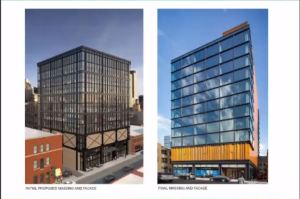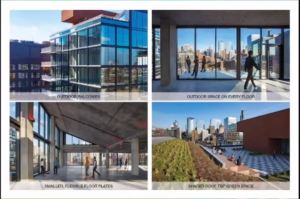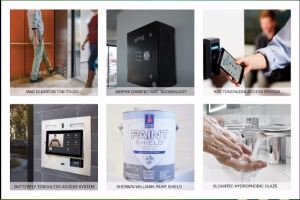A Chicago Showcase for Office’s Future
At ULI’s Fall Meeting, panelists discuss the importance of health and wellness.
Tough times often inspire progress, and a standout example took center stage this week in Chicago—Fulton East, the city’s first post-pandemic workplace.
The $26 million project originated in 2019, when Parkside Realty commissioned the design/build team of Lamar Johnson Collaborative and Clayco to develop a 12-story, 90,000-square-foot office development in Chicago’s Fulton Market District.
READ ALSO: ‘Virus Economics’ and the Commercial Real Estate Industry
Wellness was high on Parkside’s priorities list even before the pandemic, reported Bob Wislow at ULI’s Fall Meeting, a Chicago native who founded the firm in partnership with Camille Julmy in 1978. The site at 215 North Peoria was acquired with biophilia in mind as the main way to differentiate the project in a neighborhood that’s rich in historic buildings.
Employee health and wellness will be the most important features for office life in the future, Winslow told the audience, and wellness will supersede other certification programs. He cited research indicating that buildings with abundant workspace and a high ratio of exterior glass to interior space enjoy distinct benefits: Productivity jumps as much as 15 percent, sick days falls 6 percent, employee complaints of headaches and eyestrain plummet 85 percent and employee turnover declines.
Producing value
He offered an example of how an emphasis on health and wellness translates into added value for the company leasing the space. Suppose that the average annual cost of per worker is $100,000, including salaries, benefits, recruitment and turnover expenses, Winslow said. If the worker occupies 200 square feet, that adds up to $500 per employee annually.
Increasing productivity 5 percent equates to adding $25 per square foot in value; a 10 percent increase adds $50 per square foot, and so on. “In essence, being in a building that can produce those kinds of results … basically pays the rent,” said Wislow.
Also participating in the panel were Lamar Johnson, the project architect; Otto Nichols, executive vice president & shareholder at Clayco; and Ken Witkowski, senior vice president at Calamos Investments, which will house as many as 100 employees in Fulton East’s top floors starting in May 2022.
Because the project was underway at the onset of the pandemic, the project team pivoted to create a wellness-centered biophilic building. The office tower is clad in a $1.2 million high-performance glass window wall system that offers expansive views while allowing optimal daylight onto the building’s tenant spaces.
To avoid blocking tenant views and rise above nearby historic buildings, the property features three levels of parking on top of ground-floor retail. Stories five through 12 offer 10,605 of net rentable square feet per floor. An 8,000-square-foot rooftop park offers space for relaxation as well as for meetings of as many as 80 people. The smaller floorplates provide private restrooms, corridors and 9-foot by 27-foot outdoor balconies.
Changing course
To adapt to unexpected conditions, the project team implemented new measures when construction was already in progress. Elevators were already installed when COVID-19 hit and had to be re-thought. Fulton East is the first new construction to feature MAD Elevator’s Toe-To-Go system, which uses foot-activated buttons for a hands-free ride.
Another tech advancement for East Fulton is the airPHX, a non-thermal plasma technology that has been used by hospitals and dental clinics. Testing has shown that the system reduces airborne and surface viruses, bacteria and mold as much as 98 percent. Sherwin-Williams Paint Shield, an EPA-registered microbicidal paint that kills aerogenes within two hours of exposure on painted surfaces, was applied to restroom walls. Restrooms also feature Sloan’s touch-free, solar-powered faucets, soap dispensers and flush valves and SloanTec Hydrophobic Glaze on all vitreous washroom fixtures.
Inside the building, access is enabled by Kisi’s cellphone-activated touchless system; entrance is provided by a ButterflyMX touch-free intercom.
These upgrades mean cost increases, which Wislow estimated at $200,000, but panelists agreed that the investment was well worth it. From the tenant’s perspective, that the additional features were a value-add for Calamos Investments, Witkowski noted. Workers are looking beyond monetary compensation, and an employer that supports employee health will attract talent and build the team’s confidence.











You must be logged in to post a comment.